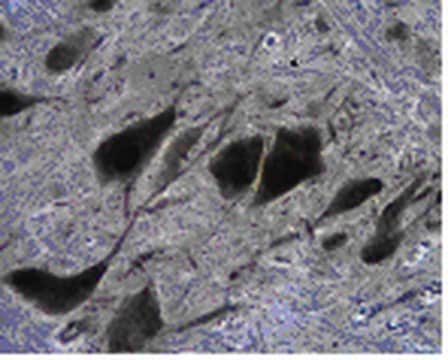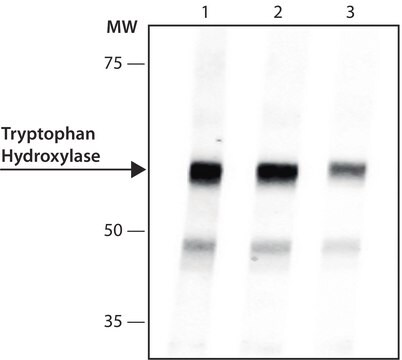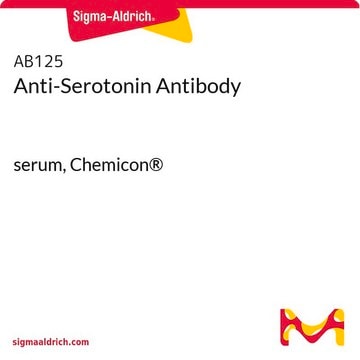Transportation information can be found in Section 14 of the product's (M)SDS.To access the shipping information for this material, use the link on the product detail page for the product.
推薦產品
產品名稱
色氨酸羟化酶单克隆抗体 小鼠抗, clone WH-3, ascites fluid
生物源
mouse
共軛
unconjugated
抗體表格
ascites fluid
抗體產品種類
primary antibodies
無性繁殖
WH-3, monoclonal
分子量
antigen 55 kDa
包含
15 mM sodium azide
物種活性
human, monkey, rabbit, rat
技術
immunohistochemistry: suitable
indirect ELISA: suitable
microarray: suitable
western blot: 1:1,000 using rabbit pineal gland extract
同型
IgG3
UniProt登錄號
運輸包裝
dry ice
儲存溫度
−20°C
目標翻譯後修改
unmodified
基因資訊
human ... TPH1(7166) , TPH2(121278)
rat ... Tph1(24848) , Tph2(317675)
一般說明
特異性
免疫原
應用
- 酶联免疫吸附测定(ELISA)
- 免疫组织化学
- 免疫印迹
- 免疫细胞化学
生化/生理作用
免責聲明
未找到適合的產品?
試用我們的產品選擇工具.
儲存類別代碼
10 - Combustible liquids
水污染物質分類(WGK)
nwg
閃點(°F)
Not applicable
閃點(°C)
Not applicable
從最近期的版本中選擇一個:
分析證明 (COA)
客戶也查看了
-
What is the Department of Transportation shipping information for this product?
1 answer-
Helpful?
-
-
Do you have an immunohistochemistry protocol for use with Product T0678, Monoclonal Anti-Tryptophan Hydroxylase antibody produced in mouse?
1 answer-
Free floating sections (4% paraformaldehyde fixation)1. Incubate 30 minutes at room temperature in 0.3% Triton X-100, 5% normal serum.2. Incubate with the antibody diluted 1:10,000 in PBS, 0.3% Triton X-100, 3.5% normal serum and 0.05% BSA for 36-48 hours.3. Rinse 3 times for 5 minutes each in PBS.4. Add the biotinylated anti-mouse IgG3 diluted in PBS containing 0.3% Triton X-100 and 3.5% normal serum for 1 hour at room temperature.5. Rinse 3 times for 5 minutes each in PBS.6. Process with Avidin Biotin-HRP.7. Complete the reaction with a 2-10 minute incubation in PBS containing 0.05% DAB and 0.015% hydrogen peroxide (H2O2).8. Mount the sections on gel coated slides and air dry.
Helpful?
-
-
Does Product T0678, Monoclonal Anti-Tryptophan Hydroxylase antibody produced in mouse, cross-react with tyrosine or phenylalanine hydroxylases?
1 answer-
This antibody, unlike some other antibodies to tryptophan hydroxylases (WH) in the market, does not cross react with tyrosine hydroxylase (TH) or with phenylalanine hydroxylase (PH). The epitope recognized by the antibody is not located in the Pterin Binding Region, which is homologous among PH, TH and WH. The specificity to WH is confirmed by the single band obtained at the 55KD region, while TH has a higher MW (60-68KD), depending on the submit) and PH has a lower MW. It has also been confirmed by collaborating experts. See Journal of Neuroscience Methods, 114(2), 205-212 (2002).
Helpful?
-
-
Can Product T0678, Monoclonal Anti-Tryptophan Hydroxylase antibody produced in mouse, be used to stain mouse brain sections?
1 answer-
This antibody has been used successfully on mouse brain slices in an immunohistochemical application. The IHC results from an experiment employing T0678 at 1:500 in mouse brain slice staining clearly showed the dorsal nuclear raphe (which are the serotonergic neurons).
Helpful?
-
Active Filters
我們的科學家團隊在所有研究領域都有豐富的經驗,包括生命科學、材料科學、化學合成、色譜、分析等.
聯絡技術服務









